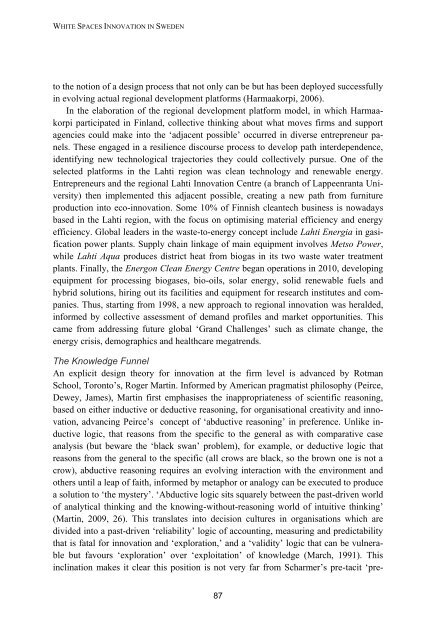White Spaces Innovation in Sweden - Innovation policy for ... - Vinnova
White Spaces Innovation in Sweden - Innovation policy for ... - Vinnova
White Spaces Innovation in Sweden - Innovation policy for ... - Vinnova
You also want an ePaper? Increase the reach of your titles
YUMPU automatically turns print PDFs into web optimized ePapers that Google loves.
WHITE SPACES INNOVATION IN SWEDENto the notion of a design process that not only can be but has been deployed successfully<strong>in</strong> evolv<strong>in</strong>g actual regional development plat<strong>for</strong>ms (Harmaakorpi, 2006).In the elaboration of the regional development plat<strong>for</strong>m model, <strong>in</strong> which Harmaakorpiparticipated <strong>in</strong> F<strong>in</strong>land, collective th<strong>in</strong>k<strong>in</strong>g about what moves firms and supportagencies could make <strong>in</strong>to the „adjacent possible‟ occurred <strong>in</strong> diverse entrepreneur panels.These engaged <strong>in</strong> a resilience discourse process to develop path <strong>in</strong>terdependence,identify<strong>in</strong>g new technological trajectories they could collectively pursue. One of theselected plat<strong>for</strong>ms <strong>in</strong> the Lahti region was clean technology and renewable energy.Entrepreneurs and the regional Lahti <strong>Innovation</strong> Centre (a branch of Lappeenranta University)then implemented this adjacent possible, creat<strong>in</strong>g a new path from furnitureproduction <strong>in</strong>to eco-<strong>in</strong>novation. Some 10% of F<strong>in</strong>nish cleantech bus<strong>in</strong>ess is nowadaysbased <strong>in</strong> the Lahti region, with the focus on optimis<strong>in</strong>g material efficiency and energyefficiency. Global leaders <strong>in</strong> the waste-to-energy concept <strong>in</strong>clude Lahti Energia <strong>in</strong> gasificationpower plants. Supply cha<strong>in</strong> l<strong>in</strong>kage of ma<strong>in</strong> equipment <strong>in</strong>volves Metso Power,while Lahti Aqua produces district heat from biogas <strong>in</strong> its two waste water treatmentplants. F<strong>in</strong>ally, the Energon Clean Energy Centre began operations <strong>in</strong> 2010, develop<strong>in</strong>gequipment <strong>for</strong> process<strong>in</strong>g biogases, bio-oils, solar energy, solid renewable fuels andhybrid solutions, hir<strong>in</strong>g out its facilities and equipment <strong>for</strong> research <strong>in</strong>stitutes and companies.Thus, start<strong>in</strong>g from 1998, a new approach to regional <strong>in</strong>novation was heralded,<strong>in</strong><strong>for</strong>med by collective assessment of demand profiles and market opportunities. Thiscame from address<strong>in</strong>g future global „Grand Challenges‟ such as climate change, theenergy crisis, demographics and healthcare megatrends.The Knowledge FunnelAn explicit design theory <strong>for</strong> <strong>in</strong>novation at the firm level is advanced by RotmanSchool, Toronto‟s, Roger Mart<strong>in</strong>. In<strong>for</strong>med by American pragmatist philosophy (Peirce,Dewey, James), Mart<strong>in</strong> first emphasises the <strong>in</strong>appropriateness of scientific reason<strong>in</strong>g,based on either <strong>in</strong>ductive or deductive reason<strong>in</strong>g, <strong>for</strong> organisational creativity and <strong>in</strong>novation,advanc<strong>in</strong>g Peirce‟s concept of „abductive reason<strong>in</strong>g‟ <strong>in</strong> preference. Unlike <strong>in</strong>ductivelogic, that reasons from the specific to the general as with comparative caseanalysis (but beware the „black swan‟ problem), <strong>for</strong> example, or deductive logic thatreasons from the general to the specific (all crows are black, so the brown one is not acrow), abductive reason<strong>in</strong>g requires an evolv<strong>in</strong>g <strong>in</strong>teraction with the environment andothers until a leap of faith, <strong>in</strong><strong>for</strong>med by metaphor or analogy can be executed to producea solution to „the mystery‟. „Abductive logic sits squarely between the past-driven worldof analytical th<strong>in</strong>k<strong>in</strong>g and the know<strong>in</strong>g-without-reason<strong>in</strong>g world of <strong>in</strong>tuitive th<strong>in</strong>k<strong>in</strong>g‟(Mart<strong>in</strong>, 2009, 26). This translates <strong>in</strong>to decision cultures <strong>in</strong> organisations which aredivided <strong>in</strong>to a past-driven „reliability‟ logic of account<strong>in</strong>g, measur<strong>in</strong>g and predictabilitythat is fatal <strong>for</strong> <strong>in</strong>novation and „exploration,‟ and a „validity‟ logic that can be vulnerablebut favours „exploration‟ over „exploitation‟ of knowledge (March, 1991). This<strong>in</strong>cl<strong>in</strong>ation makes it clear this position is not very far from Scharmer‟s pre-tacit „pre-87
















